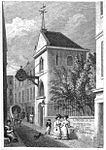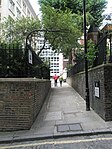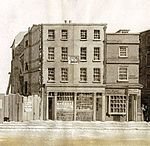Equestrian statue of the Duke of Wellington, City of London
1844 establishments in the United Kingdom1844 sculpturesBronze sculptures in the United KingdomEquestrian statues in the United KingdomGrade II listed buildings in the City of London ... and 8 more
Grade II listed monuments and memorialsMilitary memorials in LondonMonuments and memorials in LondonOutdoor sculptures in LondonSculptures of men in the United KingdomStatues in LondonStatues of Arthur Wellesley, 1st Duke of WellingtonUse British English from August 2015

The equestrian statue of the Duke of Wellington is an outdoor sculpture of Arthur Wellesley, 1st Duke of Wellington, a British soldier and statesman, located at the Royal Exchange in London. It overlooks Bank junction in the historic City of London. The sculptor was Francis Leggatt Chantrey. The statue commemorates Wellington's assistance to the City of London in ensuring that a bill was passed to allow the rebuilding of London Bridge.
Excerpt from the Wikipedia article Equestrian statue of the Duke of Wellington, City of London (License: CC BY-SA 3.0, Authors, Images).Equestrian statue of the Duke of Wellington, City of London
Cannon Street, City of London
Geographical coordinates (GPS) Address Nearby Places Show on map
Geographical coordinates (GPS)
| Latitude | Longitude |
|---|---|
| N 51.510833333333 ° | E -0.087777777777778 ° |
Address
Cannon Street 110
EC4N 6EU City of London
England, United Kingdom
Open on Google Maps











